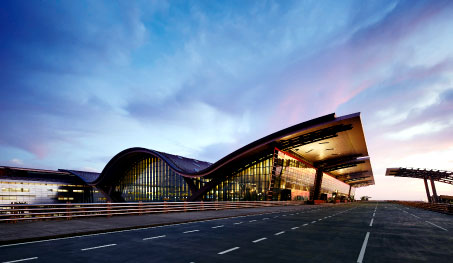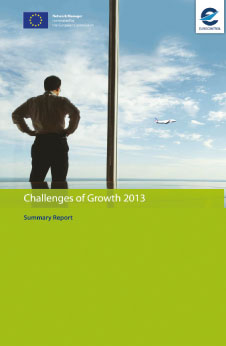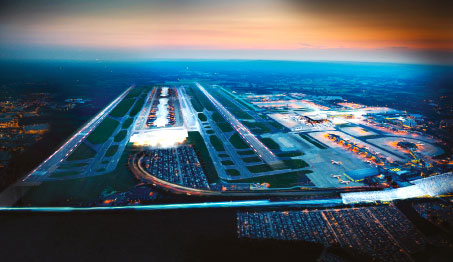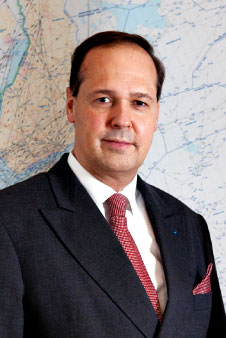
The new Hamad International Airport in Qatar is among the major airport developments in the Middle East that highlight the strategic importance placed on developing air transport infrastructure in the region.

EUROCONTROL’s Challenges of Growth 2013 report highlights that airport capacity is now expected to increase by just 17% by 2035, whereas in the 2008 Challenges of Growth report, plans indicated a 38% increase by 2030. The result of this will be 12% of demand going unaccommodated because of insufficient airport capacity – or 237 million passengers unable to fly.
One of the key figures that was on everyone’s lips at this year’s ACI EUROPE Annual Congress related to the economic impact of the looming airport capacity crunch. ACI EUROPE Director General Olivier Jankovec gave a preview of some of the report’s findings. EUROCONTROL’s startling figures show by 2035, some 20 airports in Europe will face the kind of congestion that Heathrow has today. This will cause a further ripple effect across the airport network and the capacity crunch will cost airports and airlines more than €40 billion in lost revenues and €5 billion in congestion costs, annually. ACI EUROPE estimates that the wider economic impact will be even more dramatic, with insufficient airport capacity expected to cost Europe €230 billion in lost GDP.
Aviation can play a key strategic role in fostering jobs and growth, which, in Europe’s present economic climate, should be considered all the more important. But the industry is facing a difficult time, in which Europe’s governments are failing to capitalise on the fact that airports generate economic growth. It was a fact highlighted by Declan Collier, CEO London City Airport and then-ACI EUROPE President, at the Joint ACI EUROPE/WORLD Annual Congress & Exhibition in Istanbul in June. “Short-termism, micro-politics, regulatory burden, red tape, bilateralism and the urge to refill the State coffers are the forces that continue to pay havoc with the European aviation sector. Few European countries have a thoroughly thought-through and fully formulated aviation policy. Long-term challenges are being ignored at our peril,” he asserted.
The reality is that Europe is falling behind. Airports are being forced to reduce their expansion plans through economic pressures, lack of political support and poor planning processes, and capacity is simply not being scaled up sufficiently quickly. This will not be helped by the proposed curbing of investment aid to airports with over five million passengers, as part of the European Commission’s new State aid guidelines. According to EUROCONTOL, airport capacity is now expected to increase by just 17% by 2035, whereas in the 2008 Challenges of Growth report, plans indicated a 38% increase by 2030.
The result of this will be 12% of demand going unaccommodated because of insufficient airport capacity – or 1.9 million flights not taking place and 237 million passengers unable to fly. EUROCONTROL’s figures are unequivocal and clearly point to another difficulty for the realisation of the EU’s flagship transport project, the Single European Sky.
However, expanding airport capacity isn’t just about planning and statistics. The instrumental role of airports in society is being taken for granted by European governments. If you don’t believe it, simply look at efforts to build new airports in Europe, many of which are beset by problems.
Plans for the new €3 billion Lisbon Airport were confirmed by the Portuguese Government in 2008. Construction was to begin in late 2010 or early 2011, but in May 2010 was put on hold due to the financial crisis.
Munich Airport’s campaign for a third runway has also faltered, due to local politics. Similarly, the new Notre-Dame-des-Landes airport, north-west of Nantes, has split political opinion and met with strong opposition. The project to replace Nantes-Atlantique as the main airport serving the region was originally tabled over a decade ago. The annual capacity at Nantes-Atlantique is three million and its proximity to the city centre prohibits expansion. A political greenlight for the new airport was given in 2008, with construction to start in 2014 and an opening date of 2017. The initial planned capacity is four million passengers per year, rising to nine million by 2050, however the project is currently a regular subject in the French media, due to a series of elaborate publicity stunts by a protest group. Construction of the new airport is now expected to begin in 2017 at the earliest.

London-Gatwick is among the UK airports to have responded to the Davies Commission. It has submitted a proposal for a second runway located to the south of the current site. The Davies Commission is due to deliver an interim report at the end of 2013, and its full report in summer 2015.
Running an airport is famously complex and so is the challenge of building one. Perhaps the most widely reported such case internationally is the saga of Berlin Brandenburg Airport Willy Brandt, which has also suffered from political interference. Originally due to open in 2010, with an initial annual capacity of 27 million passengers, it has been the subject of numerous delays resulting from construction problems. There is currently no opening date for the new airport. It is expected that a roadmap to the opening will be presented this autumn, once the new management team has concluded its assessment.
The UK is among those countries in which the capacity crunch will be most acute, and the convoluted debate surrounding airport capacity in London is an apt example of a lack of clear political vision. Any decision has been kicked into the long grass, with the Davies Commission not due to present its report on the way forward for UK airport capacity until after the next general election in 2015. An interim report is due at the end of 2013, and the full report in summer 2015. Heathrow, Gatwick and Stansted airports have all submitted proposals for additional runway capacity and Birmingham Airport has also put forward an alternative solution. Another proposal is for a brand new hub airport in the Thames Estuary, east of London, dubbed ‘Boris Island’ as it has been championed by Boris Johnson, the Mayor of London.
Focused aviation strategy required
There is a stark contrast between the short-sighted, burdensome regulatory approach in Europe and the strategic importance placed on aviation in the world’s emerging economic powerhouses, who clearly recognise the importance of aviation to economic growth. China, for example, is demonstrating its ability to get things done, and fast. Given its size, confidence and economic strength, it is certain that China will play a leading role on the world stage over coming decades, and the huge investment being made in the country’s transport infrastructure is key to this. China is set to open 72 new airports by 2015, in addition to more than 30 renovations at existing airports. The Middle East, too, demonstrates a fully-aligned aviation strategy, with major new airports, including Dubai’s Al Maktoum International and Qatar’s Hamad International, highlighting the strategic importance placed on developing air transport infrastructure. Meanwhile, a little closer to home, there is a clear distinction between the approaches of the EU and Turkey to airport development. Turkey has announced plans to build the world’s biggest airport in Istanbul, with six runways and an annual capacity of 150 million; the first stage of the US$10 billion (€7.5bn) hub is due to open in 2017.
The airport capacity crunch also has implications for the delivery of the Single European Sky. Europe’s airports are fully supportive of SES and the much-needed progress being made on ATM capacity and performance. However, these efforts will be fruitless unless capacity in the sky is aligned with capacity on the ground.

Frank Brenner, Director General, EUROCONTROL: “We are already today seeing delays caused by a lack of capacity. That’s a problem both with ATM capacity and also, perhaps more significantly, a lack of capacity at airports. Compared to 2012, there will be, in 2035, a lot more airports in Europe that are operating very close to capacity for long periods each day.”
Frank Brenner, Director General, EUROCONTROL, commented: “We are already today seeing delays caused by a lack of capacity. That’s a problem both with ATM capacity and also, perhaps more significantly, a lack of capacity at airports. Compared to 2012, there will be, in 2035, a lot more airports in Europe that are operating very close to capacity for long periods each day. That means a lot more delays at the airports themselves and it also makes the entire system more congested and less able to cope with any disruption, such as bad weather. And airports operating at the capacity limit are a constraint to economic growth.”
The latest Challenges of Growth report should be taken as a clear warning of the consequences of inaction over the airport capacity crunch. It reiterates and reconfirms the airport capacity challenge identified in the three previous Challenges of Growth studies. Europe’s airports must be given their licence to grow and develop infrastructure within reasonable timeframes, and following the report’s release in July, ACI EUROPE together with the AEA (Association of European Airlines) and ERAA (European Regions Airline Association) called for a European Action Plan on airport capacity to address the issue. This could involve the European Commission asking Member States to come up with national strategies on airport capacity so as to address the crunch and also deliver on the ambitious objectives of the Single European Sky. The future of European aviation urgently needs a coherent policy, one that must be delivered in the near-term.







